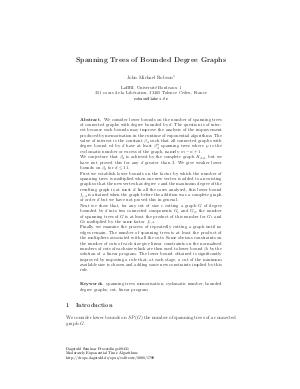Spanning Trees of Bounded Degree Graphs
Author John Michael Robson
-
Part of:
Volume:
Dagstuhl Seminar Proceedings, Volume 8431
Part of: Series: Dagstuhl Seminar Proceedings (DagSemProc) - License:
 Creative Commons Attribution 4.0 International license
Creative Commons Attribution 4.0 International license
- Publication Date: 2008-12-23
File

PDF
DagSemProc.08431.4.pdf
- Filesize: 123 kB
- 8 pages
Document Identifiers
Subject Classification
Keywords
- Spanning trees
- memorisation
- cyclomatic number
- bounded degree graphs
- cut
- linear program.
Metrics
- Access Statistics
-
Total Accesses (updated on a weekly basis)
0PDF Downloads0Metadata Views
Abstract
We consider lower bounds on the number of spanning trees of connected graphs
with degree bounded by $d$.
The question is of interest because such bounds may improve the analysis of the
improvement produced by memorisation in the runtime of exponential algorithms.
The value of interest is the constant $beta_d$ such that all connected graphs with degree bounded by $d$ have at least $beta_d^mu$ spanning trees where $mu$ is the cyclomatic number or
excess of the graph, namely $m-n+1$.
We conjecture that $beta_d$ is achieved by the complete graph $K_{d+1}$ but we have not proved this for any $d$ greater than $3$. We give weaker lower bounds on $beta_d$ for $dle 11$.
First we establish lower bounds on the factor by which the number of spanning trees is multiplied when one new vertex is added to an existing graph so that the new vertex has degree $c$ and the maximum degree of the resulting graph is at most $d$. In all the cases analysed, this lower bound $f_{c,d}$ is attained when the graph before the addition was a complete graph of order $d$ but we have not proved this in general.
Next we show that, for any cut of size $c$ cutting a graph $G$ of degree bounded by $d$
into two connected components $G_1$ and $G_2$, the number of spanning trees of $G$ is
at least the product of this number for $G_1$ and $G_2$ multiplied by the same
factor $f_{c,d}$.
Finally we examine the process of repeatedly cutting a graph until no edges remain. The number of spanning trees is at least the product of the multipliers associated with all the cuts. Some obvious constraints on the number of cuts of each size give linear constraints on the normalised numbers of cuts of each size which are then used to lower bound $beta_d$ by the solution of a linear program.
The lower bound obtained is significantly improved by imposing a rule that, at each stage, a cut of the minimum available size is chosen and adding some new constraints implied by this rule.
Cite As Get BibTex
John Michael Robson. Spanning Trees of Bounded Degree Graphs. In Moderately Exponential Time Algorithms. Dagstuhl Seminar Proceedings, Volume 8431, pp. 1-8, Schloss Dagstuhl – Leibniz-Zentrum für Informatik (2008)
https://doi.org/10.4230/DagSemProc.08431.4
BibTex
@InProceedings{robson:DagSemProc.08431.4,
author = {Robson, John Michael},
title = {{Spanning Trees of Bounded Degree Graphs}},
booktitle = {Moderately Exponential Time Algorithms},
pages = {1--8},
series = {Dagstuhl Seminar Proceedings (DagSemProc)},
ISSN = {1862-4405},
year = {2008},
volume = {8431},
editor = {Fedor V. Fomin and Kazuo Iwama and Dieter Kratsch},
publisher = {Schloss Dagstuhl -- Leibniz-Zentrum f{\"u}r Informatik},
address = {Dagstuhl, Germany},
URL = {https://drops.dagstuhl.de/entities/document/10.4230/DagSemProc.08431.4},
URN = {urn:nbn:de:0030-drops-17997},
doi = {10.4230/DagSemProc.08431.4},
annote = {Keywords: Spanning trees, memorisation, cyclomatic number, bounded degree graphs, cut, linear program.}
}
